Detailed Overview: Chemistry in Everyday Life | Chemistry for JEE Main & Advanced PDF Download
Drugs are any chemical substances that affect/alter physiology when taken into a living system. When a drug is therapeutically active and is used for the diagnosis, treatment or prevention of a disease, it is called medicine. It is the drug interactions with macromolecules inside the body that generate a biological response.
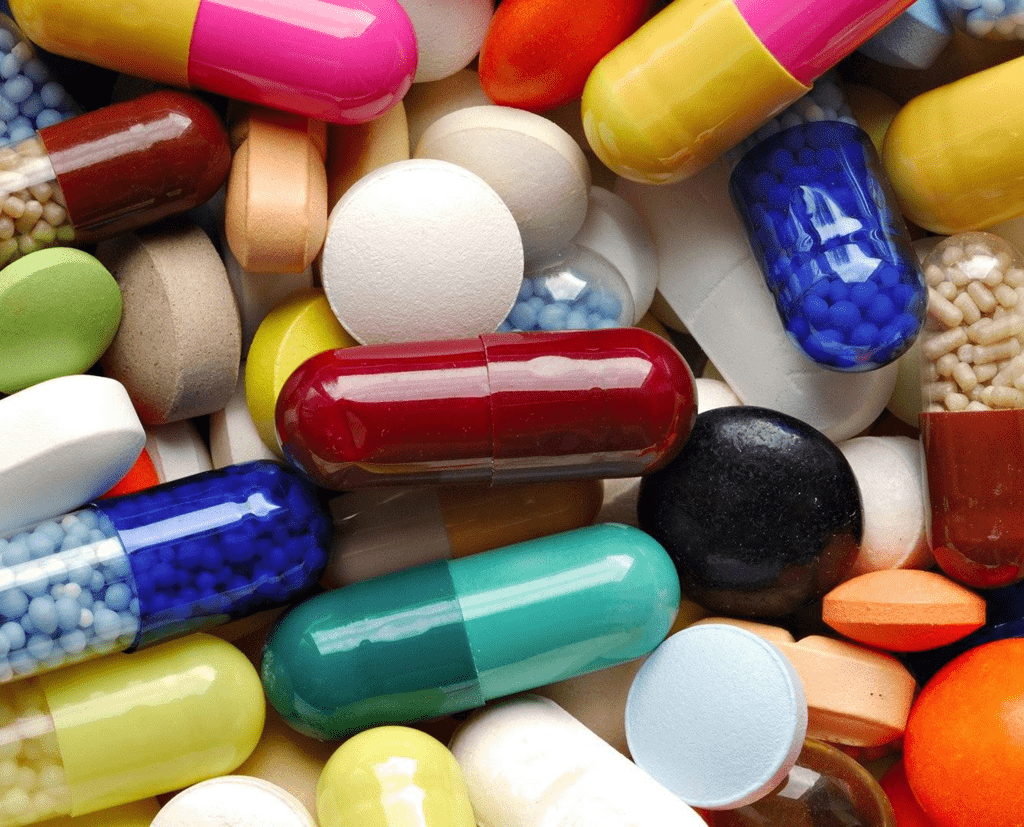
Drugs and Drug Target
- Molecular targets are one of the criteria for the classification of drugs. Here the drugs are classified based on their target molecule.
- In the body, macromolecules are the primary targets of drugs. Once a drug is ingested, it will bind to some macromolecules to generate a biological response. Such macromolecules are called target molecules or drug targets.
- We know enzymes as a biological catalyst that hastens the biochemical reaction within a living system.
- Enzymes are protein molecules that are also drug target. Another drug target is the receptors that help with the communication of cells of the body.
- The drug interactions with these molecules explain the drug action. Here we will discuss enzymes and receptors as drug targets.
Enzymes as Drug Targets
- The catalytic function of an enzyme can be explained with the help of its properties. Enzymes have active sites which provide a binding site for the substrates where it is attacked by the reagent.
- Additionally, enzymes offer functional groups that will attack the substrate necessary for the chemical reactions.
- A drug-enzyme interaction will interrupt this catalytic action and such drugs are called enzyme inhibitors. An enzyme inhibitor drug can accomplish this by interfering with the active site of the enzyme. There are two types of inhibitor drugs- competitive inhibitors and noncompetitive inhibitors.
Drug-Enzyme Interaction
At certain times the actions of enzymes need to be controlled and we do this with the help of drugs known as enzyme inhibitors. Here the enzyme will be the drug target, i.e. the drug will try to impede with the functioning of the enzyme. This can be done in one of two ways,
- Some drugs will rival the substrate by attaching themselves to the active site of the enzyme. They are known as competitive inhibitors.
- This will not allow the substrate to attach itself to the enzyme, and so the reaction will not occur. But if the concentration of the substrate is far greater than that of the drug, such a method will not work successfully.
- Then the inhibitors known as allosteric inhibitors will attach itself to the allosteric site of the enzymes. This is any other site than the active site.
- By doing so they will change the shape and structure of the enzyme. Now the substrate cannot recognize the enzyme, and won’t attach itself to the active site, thus inhibiting the catalytic reaction.
Receptors as Drug Targets
- Receptors are also a protein in our bodies. Their main function is to facilitate communication, between two neurons and between neurons and muscles.
- These biomolecules help us communicate via certain specific chemicals, known as chemical messengers.Receptors are usually found in the membrane of cells. They are embedded in the cell membrane in a very peculiar way.
- Most of their body is contained within the membrane. Only a small portion of the molecule projects out of the membrane in the region outside the cell. This region that projects out, contains the active site of the receptor.
- So when a chemical messenger approaches the receptor, it binds to the active site of the receptor, and the shape of the molecule will change. This will transmit the message to the cell, inside the membrane.
- So the message will be relayed to the cell, without the chemical messenger even entering the cell.
- There are numerous types of receptors in the human body. These receptors interact with many chemical messengers.
- The receptors are able to identify their particular messenger, because of the difference in the shape, structure and the chemical composition of the active sites. This allows the receptors and the messengers to interact with selectivity.
- The drugs that target these receptors do so by impeding its natural functioning. They attach to their active site and inhibit their actions, and block the communication of the message.
- These are known as antagonists, examples include naltrexone and naloxone. Another way a drug targets receptors is by mimicking the natural messengers. This activates the receptors and will produce some kind of biological response. Such drugs that elicit a response from receptors are known as agonists.
Classification of Drugs
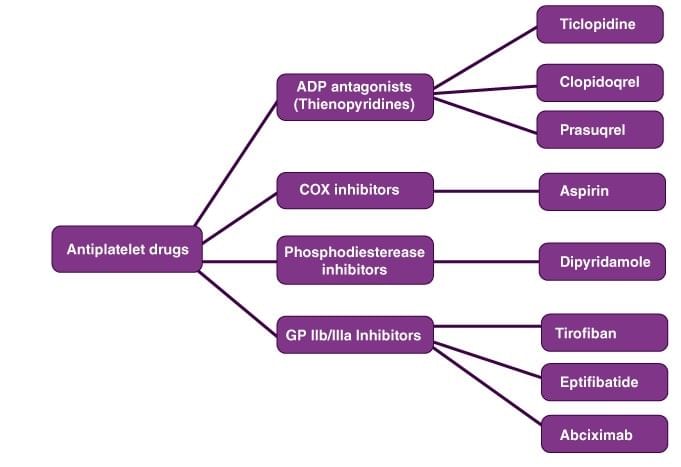
(i) On the basis of pharmacological effect:
This classification provides doctors with the whole range of drugs available for the treatment of a particular type of problem. Hence, such a classification is very useful to doctors.
(ii) On the basis of drug action:
This classification is based on the action of a drug on a particular biochemical process. Thus, this classification is important.
(iii) On the basis of chemical structure:
This classification provides the range of drugs sharing common structural features and often having similar pharmacological activity.
(iv) On the basis of molecular targets:
This classification provides medicinal chemists with the drugs having the same
Therapeutic Action of Different Classes of Drugs
Antacid
Therapeutic Action of Different Classes of Drugs
The chemical substances which neutralize the excess acid in gastric juice and raise the pH to an appropriate level in the stomach are based antacids.
The most commonly used antacids are weak bases such as sodium bicarbonate sodium hydrogen carbonate, [NaHCO3], magnesium hydroxide [Mg(OH)2] and aluminium hydroxide [Al(OH)3].
Generally, liquid antacids are more effective than tablets because they have more surface area available for interaction and neutralisation acid.
Milk is a weak antacid.
Histamine stimulates the secretion of pepsin and hydrochloric acid. The drug cimetidine [Tegamet] was designed to prevent the interaction of histamine with the receptors present in the stomach. Cimetidine binds to the receptors that triggers the release of acid the stomach. This results in release of lesser amount of acid. Now ranitidine (zantac), omeprazole and lansoprazole are used for hyperacidity.
Tranquilizers (Psychotherapeutic Drugs)
Chemical substances used for the treatment of stress, anxiety, irritability and mild or even severe mental diseases, are known as tranquilizers. These affect the central nervous system and induce sleep for the patients as well as eliminate the symptoms of emotional distress. They are the common constituents of sleeping pills.
Noradrenaline is one of the neurotransmitter that plays a role in mood change. If the level of noradrenaline is low, the signal sending activity becomes low, and the person suffers from depression. In such situations antidepressant drugs are required. These drugs inhibit the enzymes which catalyse the degradation of noradrenaline. If the enzyme is inhibited, this important neurotransmitter is slowly metabolized and can activate its receptor for longer periods of time, thus counteracting the effect of depression. Iproniazid and phenelzine are two such drugs.
Barbituric acid and its derivatives viz. veronal, amytal, nembutal, luminal, seconal are known as barbiturates. Barbiturates are hypnotic, i.e., sleep producing agents.

Equanil is used to control depression and hypertension.
Non-hypnotic chlorodiazepoxide and meprobamate are relatively mild tranquilizers suitable for relieving tension.
Analgesics:
Medicines used for getting relief from pain are called analgesics. These are of two types
1. Narcotics
Drugs which produce sleep and unconsciousness are called narcotics. These are habit forming drugs. For example, morphine and codeine. Morphine diacetate is commonly known as heroin.
2. Non-narcotics
These are non-habit forming chemicals which reduce mild to moderate inflammation such as headache, toothache, muscle and joint pain, etc. These are also termed as non-addictive. These drugs do not produce sleep unconsciousness. Aspirin (2-acetoxybenzoic acid) is most commonly used analgesic with antipyretic properties. Now these days because of its anti-blood clotting action, aspirin is widely used in heart-attacks.
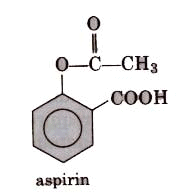
Aspirin is toxic for liver and sometimes also causes bleeding from- stomach. So, naproxen, ibuprofen, paracetamol,dichlorofenac sodium are other widely used analgesics.
Antipyretics
These are the chemical substance which reduce body temperature during high fever. Paracetamol, aspirin, phenacetin (4-hydroxy acetanilide), analgin and novalgin, etc., are common antipyretics. Out of these, paracetamol (4-acetamidophenol) is most common.

Antimicrobials
An antimicrobial tends to kill or prevent development of microbes CII inhibit the pathogenic action of microbes such as bacteria, fungi and virus selectively.
[Sulpha drugs constitute a group of drugs which are derivatives of sulphanilamide and have great antimicrobial capacity. Thus, these are widely used against diseases such as dyptheria, dysentry, tuberculosis, etc.]
In structure, these drugs are analogues of p-amino benzoic acid. Different types of antimicrobial drugs are as follows:
Antibiotics
These are the substances (produced wholly or partially by chemical synthesis) which in low concentrations inhibit the growth of microorganisms or destroy them by intervening in their metabolic processes.
Antibiotics are products of microbial growth and thus, antibiotic therapy has been linked to ‘setting one thief against another’.
Antibiotics are of two types :
- Bactericidal antibiotics have cidal (killing) effect on microbes. For example, penicillin, ofloxacin, amino glycosides, etc.
- Bacteriostatic antibiotics have a static (inhibitory) effect on microbes. For example, erythromycin, tetracycline, chloramphenicol, etc.
Penicillin was the first antibiotic discovered (by Alexander Fleming) in 1929. It is a narrow-spectrum antibiotic. Ampicillin and amoxicillin are semi-synthetic modifications of penicillin. Penicillin is not suitable to all persons and some persons are allergic to it. Consequently, it is essential to test the patients for sensitivity (or allergy) to penicillin, before it is administered.
In India, penicillin is manufactured at Pimpri and Rishikesh (Uttarakhand).
Broad-spectrum antibiotics also called antibiotics, are antibiotics which are effective against different types of harmful micro-organisms. e.g., Tetracycline, chloramphenicoltgiven in case of typhoid, dysentery, fever ofloxacin, etc.
Antiseptics
These are the chemicals which either kill or prevent the growth microorganisms. Antiseptics are applied to the living tissues such as wounds, cuts, ulcers and skin diseases in the form of antiseptic creams like furacin and soframycin. e.g., Some important examples of antiseptics are:
(i) Dettol is a mixture of chloroxylenol and terpineol.
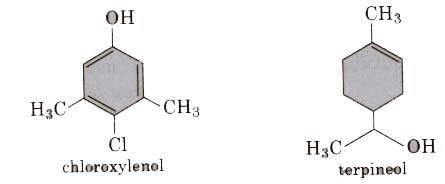
(ii) Bithional is added to soaps to impart antiseptic properties to reduce the odour produced by bacterial organic matter on the skin.
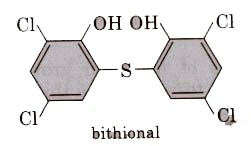
(iii) Tincture of iodine is a 2-3% solution of iodine in alcohol, which is a powerful antiseptic for wounds.
(iv) Iodoform (CHI3) is also used as an antiseptic for wounds.
(v) Boric acid in dilute aqueous solution is weak. Its formula is H3BO3.
Disinfectants
These are the chemical substances which kill micro-organisms not safe to be applied to the living tissues. They generally kill the micro-organisms present on inanimate objects such as drainage systems, instruments, etc.
Some common examples of disinfectants are as follows :
(i) 1% phenol solution is disinfectant while in lower concentration i.e., 0.2% solution of phenol is antiseptic.
(ii) 0.2-0.4 ppm aqueous solution of chlorine is used for sterilisation of water to make it fit for drinking purpose.
(iii) SO2 at very low concentration behaves like disinfectant.
(iv) Formaldehyde (HCHO) in the disinfecting rooms and operation gaseous theatres forms is used in hospitals.
Antifertility Drugs
These are the chemical substances used to control the pregnancy. These are also called oral contraceptives. They belong to the class of natural products, known as steroids.
Birth control pills essentially contain a mixture of synthetic estrogen and progesterone derivatives. Norethisterone is widely used as an antifertility drug.
|
334 videos|651 docs|300 tests
|
FAQs on Detailed Overview: Chemistry in Everyday Life - Chemistry for JEE Main & Advanced
| 1. What are drug targets? |  |
| 2. What are some common drug targets? |  |
| 3. What is the difference between antibiotics and antimicrobials? |  |
| 4. What is the therapeutic action of antacids? |  |
| 5. What are the different classes of psychotherapeutic drugs? |  |


















